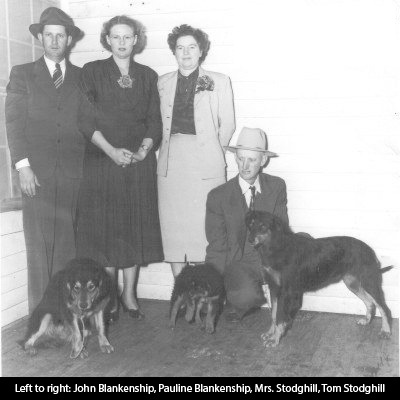
Some Dogs Said True English Shepherds - A Critical Review
Re. “Some Farm Dogs Said True English Shepherds.” The Rutherford Courier, 23 Jan. 1953
The newspaper article "Some Dogs Said True English Shepherds" offers insight into the heritage of the English Shepherd breed, a cornerstone of early 20th-century rural American life. At the heart of the article is Tom D. Stodghill’s journey back to Middle Tennessee. Stodghill came to Tennessee in search of dogs that paralleled those his grandfather had once cherished. His quest, rooted in personal history and a passion for the breed, marks a pivotal moment in the conservation of the English Shepherd.
“ [..] He found a number of dogs over Middle Tennessee that he says are quite evidently true English Shepherds and could be registered in the recently-established English Shepherd club, thus establishing new blood lines. Some Middle Tennessee families owning these dogs did not even know what breed the dogs were, only that the dogs were excellent for handling livestock and had been used in the families for this purpose for years. But color marking and other features as well as the performance of these dogs show definitely that they are of the English Shepherd breed and have been bred true down through the years.”
A significant outcome of Stodghill’s journey was the establishment of the English Shepherd Club of America. This move represented a formal step towards preserving and promoting the breed. The ESCOA played a crucial role in setting standards, registering new bloodlines, and serving as a communal platform for breed enthusiasts.
The Blankenships, noted as the largest breeders of English Shepherds in Tennessee, were instrumental in the breed's national proliferation. Their initial acquisition of a registered English Shepherd from Stodghill sparked a breeding program that would become synonymous with the breed’s excellence. Their dedication not only maintained the breed's standard but also enriched its genetic pool.
The article highlights the English Shepherd’s versatility as a working dog capable of herding, guarding, and hunting. These attributes, coupled with their intelligence and obedience, made them invaluable assets on farms. The breed's adaptability and temperament are celebrated, painting a picture of a dog not just as a working animal, but as a loyal companion and family member. The preservation of the English Shepherd's characteristics and standards is a central theme. Plans for a breeders' manual and potential magazine publications suggest a concerted effort to educate and guide future breeding. The importance of maintaining genetic diversity through the registration of unrelated bloodlines is particularly emphasized, showcasing a forward-thinking approach to breed conservation.
Finally, the article encapsulates the breed's significance in rural American culture, particularly in Tennessee and Texas. This cultural and regional impact highlights the breed’s role beyond mere functionality, embedding it in the social fabric of rural life. ▪The newspaper article "Some Dogs Said True English Shepherds" (“Some Farm Dogs Said True English Shepherds”) offers insight into the heritage of the English Shepherd breed, a cornerstone of early 20th-century rural American life. At the heart of the article is Tom D. Stodghill’s journey back to Middle Tennessee. Stodghill came to Tennessee in search of dogs that paralleled those his grandfather had once cherished. His quest, rooted in personal history and a passion for the breed, marks a pivotal moment in the conservation of the English Shepherd.
“ [..] He found a number of dogs over Middle Tennessee that he says are quite evidently true English Shepherds and could be registered in the recently-established English Shepherd club, thus establishing new blood lines. Some Middle Tennessee families owning these dogs did not even know what breed the dogs were, only that the dogs were excellent for handling livestock and had been used in the families for this purpose for years. But color marking and other features as well as the performance of these dogs show definitely that they are of the English Shepherd breed and have been bred true down through the years.”
A significant outcome of Stodghill’s journey was the establishment of the English Shepherd Club of America. This move represented a formal step towards preserving and promoting the breed. The ESCOA played a crucial role in setting standards, registering new bloodlines, and serving as a communal platform for breed enthusiasts.
The Blankenships, noted as the largest breeders of English Shepherds in Tennessee, were instrumental in the breed's national proliferation. Their initial acquisition of a registered English Shepherd from Stodghill sparked a breeding program that would become synonymous with the breed’s excellence. Their dedication not only maintained the breed's standard but also enriched its genetic pool.
The article highlights the English Shepherd’s versatility as a working dog capable of herding, guarding, and hunting. These attributes, coupled with their intelligence and obedience, made them invaluable assets on farms. The breed's adaptability and temperament are celebrated, painting a picture of a dog not just as a working animal, but as a loyal companion and family member. The preservation of the English Shepherd's characteristics and standards is a central theme. Plans for a breeders' manual and potential magazine publications suggest a concerted effort to educate and guide future breeding. The importance of maintaining genetic diversity through the registration of unrelated bloodlines is particularly emphasized, showcasing a forward-thinking approach to breed conservation.
Finally, the article encapsulates the breed's significance in rural American culture, particularly in Tennessee and Texas. This cultural and regional impact highlights the breed’s role beyond mere functionality, embedding it in the social fabric of rural life. ▪